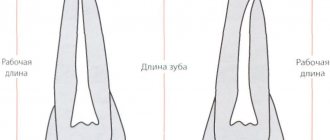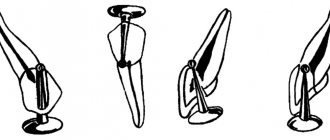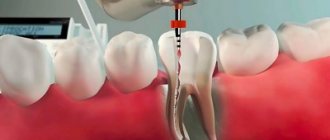Causes of obstruction of dental canals
The root canals of teeth can become obstructed for a variety of reasons. The most common include:
- features of the anatomical structure of the tooth - highly curved roots with small branches, flattened areas and transverse bridges;
- inflammatory processes in the neurovascular bundle - with dental injuries and chronic pulpitis with a subacute course, the root canals can become overgrown;
- age-related changes in tissues - over time, dentin deposits accumulate on the walls of the root canals, which lead to a narrowing of the lumen;
- dental procedures using phosphate cement - this material has a high density and cannot be destroyed by ultrasonic waves, instruments and solvents.
Before starting endodontic treatment, it is important to accurately determine whether the canals are patent.
Why re-treat canals?
Endodontic dental treatment is not always carried out in line with modern trends and requirements. According to statistics, complications in the form of chronic inflammation occur in 60-70% of patients. Treatment of dental canals is a painstaking work that must be performed by an experienced doctor using modern high-precision equipment and functional tools.
The following shortcomings of the previous intervention may serve as a reason for revising the channels:
- the presence of unfilled areas (voids). The reason is incorrect measurement of the channel length and insufficient machining;
- poor-quality filling materials, due to poor fit of which the canals become depressurized and infection opens;
- fragments of pins and instruments stuck in cavities;
- passage of additional channels and closing them along with the remains of the pulp (creation of an infectious “depot”). Molars usually have three canals, but there are specimens with four or five - they are the ones that remain “unaccounted for”;
- insufficient expansion and poor-quality cleaning of canals, formation of “steps” and root perforations due to deviation of the instrument from the anatomical shape of the course. The result is an under-processed apical part of the root (the apex of the root in dentistry means its lowest point).
As a result, the infection from the canal enters the gum tissue, and foci of chronic inflammation develop at the root tips - apical granulomas and radicular cysts. Such formations were previously considered an absolute indication for tooth extraction (cystectomy).
Endodontic treatment of tooth canals using optics
Such verdicts were completely justified, since a progressive cyst can lead to gum deformation, destruction of bone tissue (osteomyelitis), periodic inflammation and suppuration. Some dentists still consider removing a tooth with problematic roots to be the only rational option.
The IMEZA clinic has the personnel and technological capabilities for complete sanitation of cystic formations while preserving the dental unit. Our specialists have experience treating patients who were previously scheduled for tooth extraction due to the presence of foci of chronic inflammation. But there are cases when cystectomy is really the only option - destruction of more than 2/3 of the root or the impossibility of restoring the functionality of the dental unit.
Timely retreatment of questionable canals will help avoid complications and tooth loss. Our doctors objectively assess the risks and feasibility of manipulation for each individual patient, taking into account the degree of destruction of the crown and roots, the functional load on the tooth, and the possibility of subsequent restoration.
Diagnostics
Treatment of impassable root canals begins with determining their length and anatomical features. The most informative diagnostic method is radiography. To obtain accurate data on the condition of the tissues, a photograph of the tooth root is taken with the instrument inserted into it. This allows you to see:
- length of root canals,
- the presence of curvatures and perforations,
- impassable areas.
The condition of the periodontium is also assessed. This allows you to determine further treatment tactics.
Conservative treatment method
This method allows you to keep the nerve alive. This is a more preferable option, which is possible in case of a minor inflammatory process, or in the presence of a deep carious lesion, in which the lesion is close to the root, but has not yet had time to fully move to the pulp. In addition, complete and rapid nerve regeneration is possible mainly in young patients under 25-30 years of age due to the physiological characteristics of the structure and functioning of the pulp.
During the conservative treatment method, carious tissue is removed, after which a special medication is applied on top of the nerve. A temporary filling is fixed, which will reliably cover the area from bacteria and plaque. Such treatment can be repeated - the doctor assesses the condition of the dental nerve using X-rays and if the pulp regeneration is insufficient, the medicine can be prescribed for a few more days. After therapeutic treatment, the temporary filling is removed and replaced with a permanent one.
Surgical method of treatment
The surgical method is more common in the treatment of pulpitis, since the pulp most often cannot be cured and it is necessary to remove it so that the inflammatory process does not spread to the tissues around the tooth. This procedure is called depulpation or endodontic treatment.
Features of treatment
Various techniques are used to treat impassable root canals:
- devital amputation of the pulp followed by mummification,
- depophoresis.
A special approach is required if the root canal:
- strongly curved
- completely closed,
- narrowed,
- is located next to the neighboring root.
To make the canal passable along its entire length, modern dentistry uses:
- durable extractors - nickel-titanium files, which allow you to go through the canal without preliminary tooth preparation;
- drills - special instruments with spiral blades designed for quick and safe removal of gutta-percha, pastes, cements and other filling materials;
- solvents - necessary for unsealing previously sealed canals; they cope well with soft and plastic materials.
The treatment tactics for impassable root canals in each clinical case are determined by the doctor. The procedure is performed under anesthesia. Depending on the complexity, treatment is carried out in one or several stages. To obtain the desired result, 2-3 visits to the dentist may be required.
Missed canal in tooth - treatment with a microscope will help
Problem: a 34-year-old patient came to the Family Dentistry with a complaint of pain when chewing. After examining the oral cavity and performing X-ray diagnostics (dental X-ray, CT scan of the teeth), a computer tomograph revealed the causative tooth (chewing tooth on the left in the upper jaw), in which the fourth, additional channel was missed, which caused pain when chewing and an inflammatory process on the the root of the tooth (the red arrow shows the missed canal, the blue arrow shows inflammation at the root of the tooth).
Solution: the tooth canals were treated under a microscope, all canals were treated and sealed, the inflammatory process stopped, there was no pain in the tooth, the tooth was preserved (the red arrow shows the sealed canal that was missed earlier, there is no inflammation at the root).
If a tooth hurts after canal filling, most likely the canal treatment was carried out incorrectly - either the canals were not sealed tightly and they became infected, or the canals were not completely cleared of infection, or a canal or its branch was missed. Other causes of tooth pain after root canal filling are much less common. An endodontist can make an accurate diagnosis using modern X-ray equipment, especially a computed tomograph, as well as experience.
This patient complained of tooth pain when chewing. In a calm state, the tooth did not hurt. A computed tomography scan showed inflammation at the root of a tooth on the left upper jaw. The cause of inflammation could be a missed canal in the tooth. Additional canals in the upper sixth and seventh teeth are found in 97% of cases. Experienced endodontists are well aware of this, who quite often encounter missed tooth canals and the resulting inflammation at the roots. Patients turn to a specialist who works with a microscope (dentist-endodontist), when in other clinics they are offered to remove a painful tooth for unknown reasons, since they cannot find out the cause and eliminate the pain in the tooth after filling the canals.
On a CT scan of the teeth, the red arrow shows the missed canal, and the blue arrow shows inflammation at the root of the tooth:
The patient was asked to treat the canals of the teeth under a microscope and have the tooth replaced with a metal-ceramic crown. An alternative to root canal treatment may be tooth extraction and installation of a dental implant, but in this case, root canal treatment is chosen.
Periodontitis (inflammation at the roots of teeth) is successfully treated at Dial-Dent, since a dental microscope and modern endodontic instruments help to cope with the most problematic teeth with narrow, tortuous canals, which many consider “impassable.”
Root canal treatment is performed under local anesthesia. Modern anesthesia drugs make treatment painless. Treatment of tooth canals is carried out using a rubber dam - a protective scarf that isolates the tooth from saliva and the patient’s oral cavity from drugs. The use of rubber dam improves the quality of dental canal treatment and preserves the patient’s health.
First, the endodontist examines the tooth under a microscope and identifies all existing canals, and then measures the length of the canals. The x-ray shows the problematic tooth before treatment; here the missed canal is barely noticeable:
When measuring the length of the canals, the canal missed during the previous treatment is clearly visible:
Unsealing of the canals was carried out using an operating microscope and ultrasound. To eliminate infection in the tooth canals, the canals are treated with 3% sodium hypochloride solution (NAOCL), 17% EDTA solution, 2% chlorhexidine solution. After treatment, the canals were temporarily sealed with calcium hydroxide for 14 days. During this time, the infection in the canals is finally eliminated, the inflammatory process stops, and the pain goes away.
After 14 days, the patient came for a follow-up appointment. The tooth does not hurt, there are no unpleasant symptoms. The endodontist performed root canal filling using AH+ material and gutta-percha using a hybrid method. This root canal filling hermetically seals all areas of the tooth canals.
The x-ray shows permanent filling of the root canals of the tooth:
A follow-up examination and dental x-ray are scheduled after 6 months.
On a computed tomography scan after 6 months, the red arrow indicates a sealed canal (which was previously missed) and the absence of an inflammatory process at the roots of the tooth:
The doctor calculates the cost of treatment at a free consultation, after conducting an examination and taking the necessary photographs. The cost of computed tomography is 2900 rubles.
See other examples of root canal treatment under a microscope here.
Make an appointment for a consultation by phone +7-499-110-18-04 or through the form on the website. You can ask questions about dental treatment to the chief doctor of the clinic, Sergei Vladimirovich Tsukor, at








